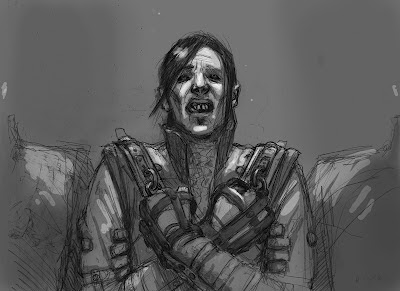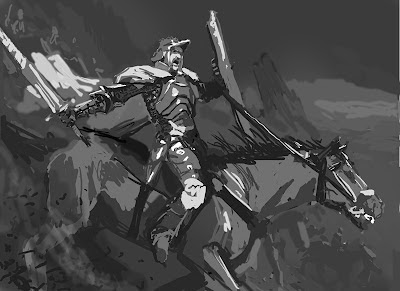Back in my day, we didn't have no internet. And by my day we're talking mid to late nineties. You'd be correct to point out that that statement is an outright lie as the world wide web was certainly a thing back then, but I'll counter with the fact that it just wasn't the same. In the years of my schooling, and for many subsequent, you could feel yourself aging as images downloaded a pixel at a time and appeared magically from left to right, top to bottom. If there was video content to speak of, it was certainly not the kind of thing that mere mortals could view with their substandard connections, and primeval, hamster-driven machines. There was email, of course, and there were chat rooms and webpages, but what hadn't really happened yet was the explosion of content out there for artists and art enthusiasts alike. There were no blogs, no demo videos, no podcasts or streaming content, and there certainly weren't extensive message board threads about the type of paint someone used, what Daarken's digital brush settings are, or how I don't know anything about the anatomy of creatures that don't actually exist.
What did we have to work with? Why, let me put on my old man pants and tell you!
While all those things listed above were certainly to come, my search for information about how other artists did things was limited to books (many of which were long out of print and thus difficult and expensive to find), obscure films that you were lucky to stumble upon a thrice budded VHS cassette of, and actually cold calling people and asking them directly. There was occasionally a lecture or live demonstration here or there, but there just wasn't the wealth of information so readily available like there is today.
At this point I pull up my old man pants and point at you meaningfully (even though it isn't polite) as I say that I hope you all appreciate the opportunities this goldmine presents. I'm happy to be living among you, late to the party in some ways, early in others, enjoying the sheer wealth of information about many of my heroes and how they won so many of their canvas duels.
But there's one thing that has begun to nag at me. The information didn't come alone. No. Uninvited, it brought along its idiot cousin as a plus one. That idiot cousin is free advice.
Now, I'm willing to take much of the information out there at face value — after all, why would someone lie to you about using a number two round dipped in a mixture of Cadmium Red Light and Yellow Ochre?Seriously. What's in it for JoJo down at the shopping mall to lie about using an airbrush to make all those t-shirts he sells? I just don't see the angle. But all those opinions out there? All that free advice? Excuse me while I get my bucket of salt, some waders, and a shovel.
Without further ado, here's some advice about that advice.
I know this may seem obvious, but it's kind of important to know a little about who the advice is coming from. Figure out whether they're worth your time, what their motives are, and whether there's actually some aspect of their work that's applicable to you. For example, were I looking for oil painting tips I'd be unlikely to go to someone who works digitally. This isn't a prejudice against digital work, mind you, as I'd be just as unlikely to consult a water colorist. And if it's a bigger issue of artistic fundamentals you're looking to solve (like composition, drawing problems, or visual communication issues), it helps to turn to someone whose sensibilities and qualities have something in common with your own — which is not to say that you should only be looking to people who do work that looks exactly like yours. Indeed, the illustrators I turn to have work that looks nothing like mine, but there are underlying threads that keep our work in the same ballpark. Similar approaches to solving problems, similar interest in story telling, etc. That synchronicity automatically makes any opinions they share more effective, as I understand better where they're coming from.
Don't Settle
While potentially overwhelming, the untold quantity of advice mines also give you the luxury of choice. As you sift through your options, it's important to remember not to settle for advice given by artists who are at your level or only marginally better than you. Sure, you might like that one piece that JoJo down at the mall did, but like an art director once told me, "everyone has one good piece in them." So what's the rest of JoJo's work look like? Why not look to someone who has a whole portfolio of good pieces? Pieces that you think are beyond what you could ever hope to achieve. And while we're at it, how about someone with a whole portfolio of good pieces and a decent amount of experience and has made a career of it? The point is, don't skimp. You don't have to. Sure it can be intimidating to contact someone you don't know, and sometimes it takes a while for these total strangers to get back to you, but it's better to wait for advice from a professional who knows what they're talking about than it is to get your instant two cents from JoJo.
More = Better
So you've ignored me and insist on going to JoJo for all his artistic ravings — I understand, he has a wise face. That's one opinion and one opinion is good. You know what's better? Two opinions. Or even three! Hearing more than one thought can help patterns emerge and can also help solutions become clearer. Plus, not everyone is going to pick up on the same things, and you might end up with multiple issues to address. While this seems like a headache, it can also help your work improve multiple times over, and in a far more compressed period of time.
Look, it's never a bad idea to get opinions from multiple sources. You can't determine the direction of a line from a single point, so it always helps to find another point...of view. See what I did there? (I hate myself for writing that). But seriously, it's a lot harder to get to the truth of things from one person's opinion, and gathering insight from more than one source is going to give you a lot more options, and may even counter-intuitively help you hone in on the best answer for you.
There are a lot of folks out there spouting off on their blogs like it's the gospel as told by the illustration god, Illustrut, himself. They shout with their conviction and dazzle with neat pictures and large, bold typography. Heck, JoJo is sporting a whole cart that's got a big sign on top of it. Clearly these kind of things and the fact that they've been paid to illustrate at some point make all those guys experts and they obviously know more than you. Right?
Perhaps not. The most important thing to remember about advice is that it's just an opinion. Sure, it might be based on facts and experiences, and sure they might be working illustrators, but such things do not turn their wisdom into a law chiseled in stone by Hammurabi*, himself. Advice can apply to you and your work, and it can also be pretty far off base, so it's vital to learn to take in what applies and ignore the rest. Part of making art is having intentions and making real choices. You know what you're trying to do better than the person giving you advice, so be sure that adhering to some of that advice doesn't betray those intentions and choices in some way.
Which brings me to my final point. While I've dispatched some advice as well as a fair amount of information about my work and process on this blog of mine, everything I've passed along has been based on my own experience. What knowledge I've provided is what worked for me, nothing more. I've also tried to include what hasn't worked whenever pertinent. Much of the advice I've given is pretty general. Indeed if you go from blog to blog looking for the secrets of life and illustration you'll note that the advice often is. There are themes of hard work and perseverance woven throughout, and many universal truths are present that you just can't get around. But remember, it's the internet, and the internet is still the Wild West. Any idiot can express their opinion half-intelligently and sound like they know what they're talking about — which includes me, by the way.
Still, I'm a big proponent of getting help on the fundamentals and then figuring the nuances out for yourself. The building blocks of what we do, while largely comprised of repetition, are often molded by other hands. A slight nudge here, a slap on the wrist there, not to mention the meticulous study and outright thievery of the work of our heroes. The big ticket items are what I go seeking information about and look to others for advice to improve. But deciding what brush to use or what colors to mix? That's all trial and error. Sure I've taken advice on that stuff, but it was me driving the bus and deciding which passengers to let on. I'm just as likely to drive right by. Remember that it's the oddities of process, the quirks, the mistakes and hiccups along the way that make our artistic endeavors our own.
So go out there and seek that advice whenever you need it, but arm yourself with a shovel of your own, and don't forget to leave some time to actually paint along the way.
* Survey of Art History 101 for the win!

















